Cite this document
(Army Marketing Shift: Snafu or Effective Exercise Case Study, n.d.)
Army Marketing Shift: Snafu or Effective Exercise Case Study. https://studentshare.org/marketing/1707132-army-of-one-marketing-campaign-marketing-product-that-failed-or-did-not-achieve-its-goals-objectives
Army Marketing Shift: Snafu or Effective Exercise Case Study. https://studentshare.org/marketing/1707132-army-of-one-marketing-campaign-marketing-product-that-failed-or-did-not-achieve-its-goals-objectives
(Army Marketing Shift: Snafu or Effective Exercise Case Study)
Army Marketing Shift: Snafu or Effective Exercise Case Study. https://studentshare.org/marketing/1707132-army-of-one-marketing-campaign-marketing-product-that-failed-or-did-not-achieve-its-goals-objectives.
Army Marketing Shift: Snafu or Effective Exercise Case Study. https://studentshare.org/marketing/1707132-army-of-one-marketing-campaign-marketing-product-that-failed-or-did-not-achieve-its-goals-objectives.
“Army Marketing Shift: Snafu or Effective Exercise Case Study”. https://studentshare.org/marketing/1707132-army-of-one-marketing-campaign-marketing-product-that-failed-or-did-not-achieve-its-goals-objectives.


